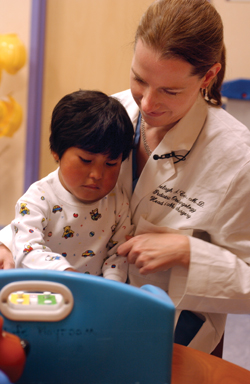
Betsy Vilca Sucari plays with Shelagh Cofer, M.D., after her surgery.
photo by Dana Johnson
Surgery’s success makes young girl’s long journey from Peru worthwhile

Three-year-old Betsy Vilca Sucari of Peru before surgery.
photo by Anne Rayner
Three-year-old Betsy Vilca Sucari managed to charm everyone she met when she visited the Monroe Carell Jr. Children's Hospital at Vanderbilt last week. To Sucari, a native of Peru, the Americans — with their strange habits, indecipherable language and interesting toys — were fun to visit with.
But to those who got to know Sucari in the one-and-a-half weeks she was here, her visit was so much more.
The little girl had a tumor on her left jaw and neck that had grown continuously since she was an infant and had become much more than just a cosmetic problem. Sucari had trouble breathing and sleeping, and at times, when she was tired, it was hard to stand and walk because of the tumor's weight.
Sucari's home is the Andes Mountains of Peru, where she lives in a small farming village with her mother and two brothers.
When her mother heard a radio ad for a special clinic held in a city some miles from her home, she managed to find a way to travel there to get her daughter examined.
Carlos Pauca, a Peruvian physician, had advertised the clinic to offer surgeries for children just like Sucari.
“My nurse, Nelly Jallurana, met Betsy's mother and arranged for her to come to see us when we had Children's Surgery International in the town of Esangaro,” Pauca said.
It was then that Shelagh Cofer, M.D., assistant professor of Pediatric Otolaryngology at VUMC, saw Sucari. Cofer was volunteering with the mission group in June.
“It was too dangerous to operate in Peru. The tumor was so close to her small airways that we knew a surgery might cause difficulty breathing unless we had the proper equipment,” said Cofer.
Cofer called on Arnold Strauss, M.D., medical director for Children's Hospital, and Jim Shmerling, the hospital's CEO, to approve medical services for the child. Cofer would offer her skill as a surgeon and would open her home to all three travelers until Sucari was well enough to return home.
Meanwhile, Sucari's charm worked wonders and within months, donors had bought a plane ticket for her, Pauca and Jallurana to travel to Vanderbilt for the surgery.
“Once we got into surgery, we realized how lucky we were,” Cofer said. “The tumor was a benign connective tissue tumor called infantile fibromatosis that was pulled out easily, with only a small section of attachment at the back of her head that had to be carefully released. Once we separated the attachment from the base of her skull, it was almost like delivering a small baby to remove that tumor from the small incision we had made in her neck.”
Throughout recovery, Sucari clung to her Champ doll, which she had named “Perrito,” (Spanish for “puppy”) and within a day or so, she was back to playing and charming once again.
She recovered well and climbed on a plane one week after the surgery and was home with her mother in Peru two days later.
Cofer said the tumor is the type that can grow back and she plans to follow Sucari clinically on future trips to Peru.
While this would have been a routine surgery here in the United State, in the Andes communities in Peru, Betsy had no option for treatment.
“Now I hope the future is brighter, not just for Betsy, who is certainly going to be more comfortable without the tumor, but also for her family,” Cofer said.
Donations are being accepted to a fund in Sucari's name to cover remaining travel costs and expenses.
For more information visit the Children's Surgery International Web Site at www.childrenssurgeryintl.org.













